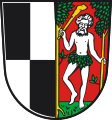Naila
| Naila | ||
|---|---|---|
|
Naila | ||
| ||
 Naila | ||
Location of Naila within Hof district  | ||
| Coordinates: 50°19′N 11°41′E / 50.317°N 11.683°ECoordinates: 50°19′N 11°41′E / 50.317°N 11.683°E | ||
| Country | Germany | |
| State | Bavaria | |
| Admin. region | Oberfranken | |
| District | Hof | |
| Government | ||
| • Mayor | Frank Stumpf (FW) | |
| Area | ||
| • Total | 37.05 km2 (14.31 sq mi) | |
| Population (2015-12-31)[1] | ||
| • Total | 7,640 | |
| • Density | 210/km2 (530/sq mi) | |
| Time zone | CET/CEST (UTC+1/+2) | |
| Postal codes | 95119 | |
| Dialling codes | 09282 | |
| Vehicle registration | HO | |
| Website | www.naila.de | |
Naila is a town in the Frankenwald hills, in the Hof district of Bavaria. Naila is situated some 18 km from the larger city of Hof. It is situated on both banks of the Selbitz river.

History
The earliest documentation of Naila dates at 1.9.1343. The first settlements in the area around Naila probably happened between the 12th and 14th century. The name Naila first appeared as "Neulins" (and variations thereof), has its origins most likely in the meaning "Small new settlement".
Up until 1972 it was the seat of the then district of Naila. The village of Marxgrün incorporated to Naila in 1978.
After World War II the Iron Curtain, just 8 km north of Naila, cut off a large part of the market for the local industries. In 1979, the town was the landing site of the Strelzyk and Wetzel families' famous balloon escape from East Germany.
See also
External links (German)
- Map of Naila
- History of the city-seal
- Description of the balloon-escape from the GDR
- official website of the city of Naila
References
- ↑ "Fortschreibung des Bevölkerungsstandes". Bayerisches Landesamt für Statistik und Datenverarbeitung (in German). June 2016.
| Wikimedia Commons has media related to Naila. |

